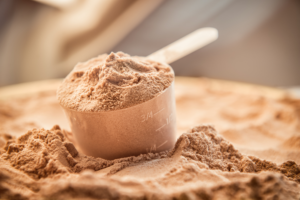
Can You Take Whole Greens as a Supplement?
Eating your greens every day is an integral part of health that dates back to well before Popeye the Sailorman. And while it is vital

You exercise at least 2.5 hours per week. You know the right foods to eat. You control your urges to eat unhealthy foods – most of the time. But occasionally, you succumb to the siren call of a double bacon cheeseburger with onion rings and french fries. Sometimes, your appetite is so voracious you lose all control. If you want to reduce your appetite and lose weight, we strongly recommend glucose control.
How Glucose Control Can Help You Reduce Appetite
Glucose Absorption
When you eat so-called fast carbs, or simple carbohydrates, your body absorbs glucose rapidly because your body breaks down the carbs quickly. Unfortunately, the faster your body absorbs glucose, the hungrier you will be. This applies even when you compare a meal with fast carbs to a meal with the same number of calories but fewer fast carbs.
When you control your glucose absorption, you will feel fuller for longer and consume fewer calories throughout the day. If you’re capable of eating intuitively, weight loss or maintenance is a breeze. Your body simply isn’t hungry after eating an adequate number of nutritious calories.
Glucose Tissue Uptake
Glucose tissue uptake in healthy individuals occurs primarily in the musculoskeletal system. Contrastingly, only 20 to 25% of glucose tissue uptake occurs in the liver and adipose tissue of healthy individuals. When your liver and fatty tissue absorb much more glucose than this, you are probably insulin resistant.
This can be a leading indicator of Type 2 Diabetes. When you control glucose tissue uptake and encourage the glucose transporters to transport glucose to your skeletal muscles, you reduce insulin sensitivity. With fewer blood sugar spikes, you do not get hunger pangs when your body doesn’t need the fuel. This results in weight loss or weight maintenance.
Conversion of Starch to Sugar
Low glycemic index foods are typically defined as those equal to or lower than 55 on the Glycemic Index. High glycemic index foods are typically defined as those equal to or greater than 70. There are three types of starches: RDS (readily digestive starch), SDS (slowly digestible starch), and RS (resistant starch). Consuming high glycemic index foods decrease satiety levels and increase hunger.
There is no meaningful evidence that consuming slowly digestible starches leads to greater whole-body energy expenditure. But there is a significant amount of irrefutable evidence that consuming slowly digestible starches increases satiety and reduces hunger. This indicates that the slower your body converts starch to sugar, the less hungry you will be, and the less food you will eat.
Insulin Resistance
Your gastrointestinal tract releases hormones known as incretins when you eat and drink. These hormones, in turn, stimulate glucose-dependent insulin secretion. Among the roles insulin plays in satiety include the impedance of gastric acid secretion, a decrease of gastric emptying, and a decrease of pancreatic enzyme secretion.
When your gastric acid secretion is impeded, your body suppresses ghrelin (hunger hormone) levels, decreases appetite and body weight, and decreases leptin, among other functions. When your body is not responsive to insulin, satiety levels do not increase, hunger levels do not decrease, you will eat above maintenance due to excessive hunger and gain weight.
How to Control Your Blood Glucose Levels
Knowing how to reduce appetite with glucose control is one thing. Actually, executing glucose control is a different beast entirely. To control your blood glucose levels, take Glucose Control 7 Ways 6.4. This proprietary blend of four natural ingredients regulates the levels of glucose in your blood by controlling critical metabolic pathways.
By regulating how your body burns sugar, you can reduce appetite, lose weight, and treat medical conditions such as metabolic syndrome. With Priority Mail shipping within the United States and a 30-day risk-free guarantee, you have nothing to lose but excess body fat.
Benefits of Glucose Control 7 Ways 6.4
With a proprietary combination of four all-natural ingredients, Glucose Control 7 Ways 6.4 benefits your health in many ways. First, it helps your body regulate its conversion of starch to sugar. Then, it supports normal glucose absorption and glucose tissue uptake. It also supports glucose homeostasis. It slows down your body’s propensity to store fat, and it controls insulin release and sensitivity.
Who Can Benefit From Glucose Control 7 Ways 6.4?
Anyone can benefit from Glucose Control 7 Ways 6.4. For instance, you may struggle to maintain your ideal weight due to reduced metabolism and decades of poor food habits. However, Glucose Control 7 Ways 6.4 most significantly benefits people who have been diagnosed with obesity, Type 2 Diabetes, or metabolic syndrome.
How Else You Can Control Blood Glucose Levels
Sometimes you have issues such as Type 2 Diabetes that impede your ability to control blood glucose levels. You need help to regulate the crucial functions that occur in your brain and gastrointestinal tract to reduce your appetite.
Glucose Control 7 Ways 6.4 helps your body regulate itself. But you won’t lose weight if you eat above maintenance. If you’re trying to lose weight, here are 3 other steps you should take to reduce appetite through glucose control to help you on your weight loss journey:
When you eat carbs, your body breaks the macronutrient into sugars, like glucose. Then, glucose is transported to cells with the help of insulin. Even if you’re taking a supplement, if you eat too many carbs, your body’s insulin can’t quite keep up, and your blood glucose levels increase.
As your insulin is being strengthened by Glucose Control 7 Ways 6.4, take care of your body, and reduce your appetite by preventing blood sugar spikes. You can do this by eating foods lower on the glycemic index or fewer overall carbs.
If you struggle to consume enough soluble fiber throughout the day, add Evvea to your daily health and wellness routine. While insoluble fiber is important for your health, soluble fiber has been proven to prevent blood sugar crashes and maintain stable blood sugar levels, even if you go a while without eating.
An excellent rule of thumb is to consume 14 grams of fiber for every 1,000 calories you consume. This equates to roughly 25 grams of fiber for women and 38 grams of fiber for men per day. Besides taking Evvea, you should also try to incorporate plenty of whole grains, legumes, fruits, and veggies into your diet.
Several studies have revealed that micronutrient deficiencies are a prevalent cause of diabetes and high blood sugar. Chromium helps you burn carbs for fuel quickly so you can get to efficient fat metabolism. It also helps you control blood glucose levels. Magnesium deficiency leads to diabetes and an inability to transport glucose to your tissues.
Start Controlling Your Glucose Today
Are you sick and tired of your best weight loss efforts being stalled due to a voracious appetite? Have you noticed your weight slowly creeping up after decades of maintenance? If so, we strongly recommend that you reduce appetite via glucose control. If you can eat intuitively, you can lose excess weight and maintain a healthy weight for life with Glucose Control 7 Ways 6.4.
At Panacea Scientific, we believe wholeheartedly in putting safe, natural products into our bodies. We welcome the opportunity to share our vision and worldview with everyone. If you have any questions, contact Panacea Scientific to learn more. If you are concerned about poor gut health, we welcome you to browse the rest of our products.

Eating your greens every day is an integral part of health that dates back to well before Popeye the Sailorman. And while it is vital

As we begin to understand the inner workings of our bodies better, one thing that we are only now starting to understand the importance of

Adding certain supplements to your diet can be incredibly beneficial for your health. Whether a physician recommends you add a supplement such as whey protein

Payment types accepted:
Visa/MC/Discover/ American Express
© Copyright Panacea Scientific 2020. All rights reserved. | Website by Infinite Web Designs